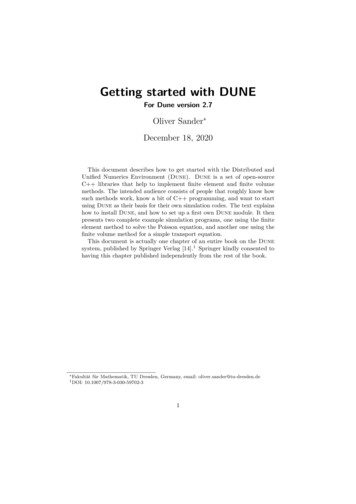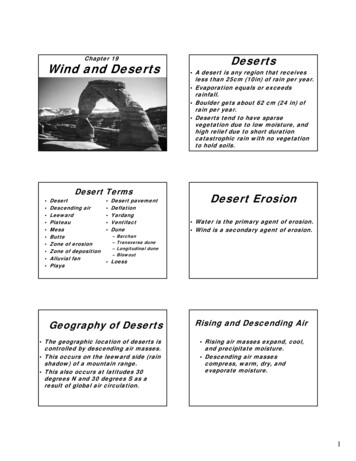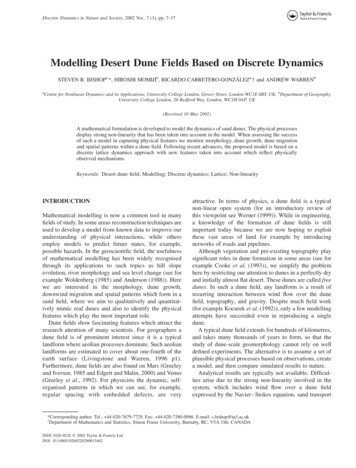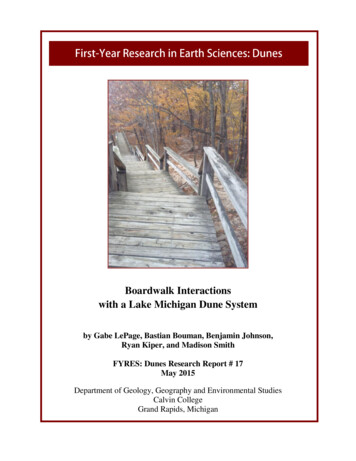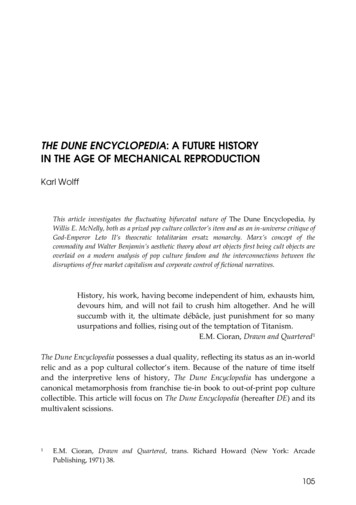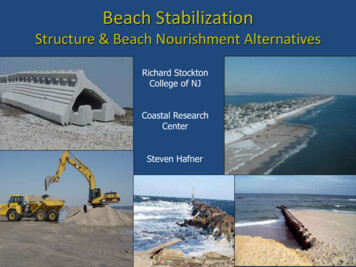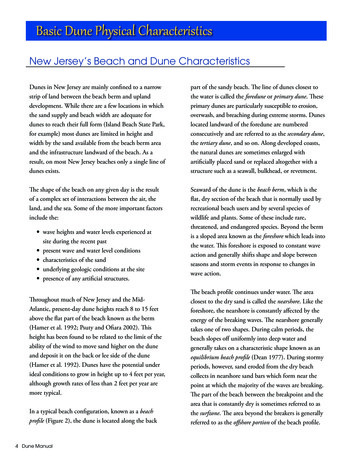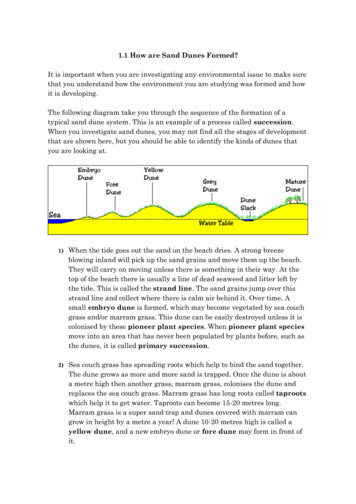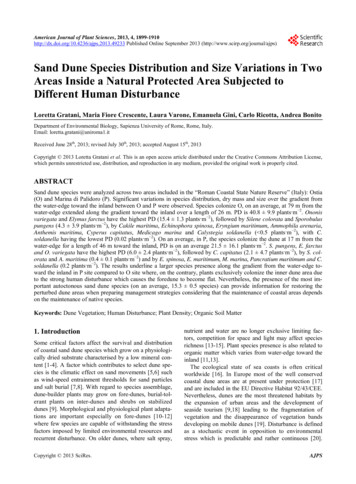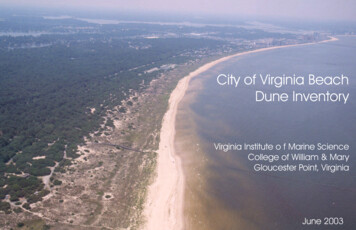
Transcription
City of Virginia BeachDune InventoryVirginia Institute o f Marine ScienceCollege of William & MaryGloucester Point, VirginiaJune 2003
City of Virginia Beach Dune InventoryC. Scott Hardaway, Jr.1Donna A. Milligan 1Lyle M. Varnell 2George R. Thomas 1Walter I. Priest2Linda M. Meneghini 1Thomas A. Barnard 2Sharon Killeen 2Shoreline Studies Program 1Department of Physical SciencesandWetlands Program 2Center for Coastal Resources ManagementVirginia Institute of Marine ScienceCollege of William & MaryGloucester Point, VirginiaThis project was funded by the Virginia Department of Environmental Quality’s Coastal Resources Management Program through Grant #NA17OZ11142-01 of theNational Oceanic and Atmospheric Administration, Office of Ocean and Coastal Resource Management, under the Coastal Zone Management Act of 1972, as amended.June 2003
Table of ContentsTable of Contents . . . . . . . . . . . . . . . . . . . . . . . . . . . . . . . . . . . . . . . . . . . . . . . . . . . . . . . . . . . . . . . . . . . . . . . iList of Figures . . . . . . . . . . . . . . . . . . . . . . . . . . . . . . . . . . . . . . . . . . . . . . . . . . . . . . . . . . . . . . . . . . . . . . . . . iList of Tables . . . . . . . . . . . . . . . . . . . . . . . . . . . . . . . . . . . . . . . . . . . . . . . . . . . . . . . . . . . . . . . . . . . . . . . . . . i1INTRODUCTION . . . . . . . . . . . . . . . . . . . . . . . . . . . . . . . . . . . . . . . . . . . . . . . . . . . . . . . . . . . . . . . . 11.1Purpose . . . . . . . . . . . . . . . . . . . . . . . . . . . . . . . . . . . . . . . . . . . . . . . . . . . . . . . . . . . . . . . . . . . 11.2Dune Act . . . . . . . . . . . . . . . . . . . . . . . . . . . . . . . . . . . . . . . . . . . . . . . . . . . . . . . . . . . . . . . . . 12BACKGROUND . . . . . . . . . . . . . . . . . . . . . . . . . . . . . . . . . . . . . . . . . . . . . . . . . . . . . . . . . . . . . . . . . 22.1Dune System Classification . . . . . . . . . . . . . . . . . . . . . . . . . . . . . . . . . . . . . . . . . . . . . . . . . . . 32.2Site Characteristics . . . . . . . . . . . . . . . . . . . . . . . . . . . . . . . . . . . . . . . . . . . . . . . . . . . . . . . . . 43DUNE DATA SUMMARY . . . . . . . . . . . . . . . . . . . . . . . . . . . . . . . . . . . . . . . . . . . . . . . . . . . . . . . . . 54INVENTORY . . . . . . . . . . . . . . . . . . . . . . . . . . . . . . . . . . . . . . . . . . . . . . . . . . . . . . . . . . . . . . . . . . . 75REFERENCES . . . . . . . . . . . . . . . . . . . . . . . . . . . . . . . . . . . . . . . . . . . . . . . . . . . . . . . . . . . . . . . . . . 7List of FiguresFigure 1.Figure 2.Figure 3.Figure 4.Location of City of Virginia Beach within the Chesapeake Bay estuarine system . . . . . . . . . 1Geographic extent of dunes in the City of Virginia Beach . . . . . . . . . . . . . . . . . . . . . . . . . . . 2Dune classification system developed by Hardaway et al. (2001) . . . . . . . . . . . . . . . . . . . . . 3Typical profile of a Chesapeake Bay dune . . . . . . . . . . . . . . . . . . . . . . . . . . . . . . . . . . . . . . . 4List of TablesTable 1.Table 2.Table 3.Identified dune sites in City of Virginia Beach as of 2000 . . . . . . . . . . . . . . . . . . . . . . . . . . . 5Dune site measurements in City of Virginia Beach as of 2000 . . . . . . . . . . . . . . . . . . . . . . . . 6Dune site parameters in City of Virginia Beach as of 2000 . . . . . . . . . . . . . . . . . . . . . . . . . . 6AcknowledgmentsAppendix A. Location of Dune SitesAppendix B. Individual Dune Inventory SheetsCover PhotoDune site VB 4, First Landing State Park, 25 June 2003 by VIMS, Shoreline Studies Program.i
1INTRODUCTION1.1PurposeNThe City of Virginia Beach is located on the southern shore of Chesapeake Bay (Figure 1). Oceancoast dunes were not included in this assessment. Primary tidal shorelines extend from Cape Henrywestward to Little Creek Inlet. Eight (8) dune sites were identified along the City of Virginia Beachshoreline on the southern shore of Chesapeake Bay (Figure 2). It is the intent of this publication to providethe user with information on the status of dunes in City of Virginia Beach. This information comes fromresearch performed in 1999 and 2000 which was presented in a report entitled “Chesapeake Bay DuneSystems: Evolution and Status (Hardaway et al., 2001). Since much of the data was collected several yearsago and the beach and dune systems may have changed, this report is intended only as a resource for coastalzone managers and homeowners; it is not intended for use in determining legal jurisdictional limits.1.2Washington DCDune ActCoastal dune systems of the Commonwealth of Virginia are a unique and valuable natural resource.Dunes are important to both the littoral marine system (as habitat for flora and fauna) and the adjacentlandward environment (as erosion control and protection from storms). These functions form the basis forthe Coastal Primary Sand Dune Protection Act of 1980 (Act)1 and the related resource management effortunder which the primary dune and beach components of existing dune systems are protected. Secondarydunes are not protected under the Act; however, as they are an important part of the overall dune system,they were included in the original report (Hardway et al., 2001) and analyzed as part of a risk assessmentperformed by Varnell and Hardaway (2002). In this inventory, both primary and secondary dunes areincluded.Primary dunes must meet three criteria in order to fall under the Act’s jurisdiction:1.2.3.Substance: a mound of unconsolidated sandy soil contiguous to mean high waterMorphology: landward and lateral limits are marked by a change in grade from 10% to 10%.Character: primary dunes must support specific plant species or communities which arenamed in the Act and include: American beach grass (Ammophila breviligulata); beachheather (Hudsonia tometosa); dune bean (Strophostylis spp.); dusty miller (Artemisiastelleriana): saltmeadow hay (Spartina patens); seabeach sandwort (Arenaria peploides); seaoats (Uniola paniculata); sea rocket (Cakile edentula); seaside goldenrod (Solidagosempervirens); and short dune grass (Panicum ararum).The General Assembly enacted the Coastal Primary Sand Dune Protection Act (the Dune Act) in 1980.The Dune Act was originally codified in Code § 62.1-13.21 to -13.28. The Dune Act is now recodified asCoastal Primary Sand Dunes and Beaches in Code § 28.2-1400 to -1420.P otom rginia BeachFigure 1. Location of City of Virginia Beach within the ChesapeakeBay estuarine system.1
Dunes act as a reservoir of sand which can buffer inlandareas from the effects of storm waves and, in the process,act as natural levees against coastal flooding. During highenergy conditions, such as the northeast storms whichfrequent the Eastern Seaboard, primary dunes may besubject to attack by wind-driven waves aided by stormsurges. The dune may be eroded, and the sand depositedin an offshore bar. Then, under low-energy conditions, thesand may move back to the beach.All dunes in the Chesapeake Bay estuarine systemare mobile features especially with regards to coastal zonemanagement. Unlike ocean dune fields that are relativelycontinuous features exposed to the open ocean, the dunesof the Chesapeake form across a temporal and spatialgeomorphic matrix driven by sand volume, varying waveclimate, and shoreline geology. The coastal geology, inlarge part, determines whether shoreline erosion acts uponthe upland (high bank) or marsh (low bank). Sand supplyand the long-term local wave climate are significantfactors in the location of dunes. The stability or ability ofa dune/beach system to accrete over time is necessary forthe formation of secondary dunes.Figure 2. Geographic extent of dunes in the City of Virginia Beach.2BACKGROUNDCoastal primary sand dunes form by the accumulation of sand due to the interaction of wind andwave action along the shore. Sand deposited on the beach during periods of relatively low wave energy ismoved landward by onshore winds. The deposition of material above the intertidal zone allows vegetationto take root along the wrack line which then acts as a baffle, slowing wind speed and causing wind-bornesand to settle and be trapped in the vegetation, thereby resulting in further accretion of the dune. Therefore,the size and location of a primary dune is determined by the amount of sand available and the ability ofwind and waves to move it as well as the degree to which any existing vegetation can act to trap it. Just asthe intensity, direction, and duration of winds and waves constantly change through the seasons, so too, docoastal dunes. They exist in a state of flux.Natural dunes in the Chesapeake Bay estuarinesystem vary in size and nature, but all require an accretedfeature, such as a beach washover or a spit to becomevegetated above the intertidal zone. Vegetation and acontinuous beach/dune profile are required to create the jurisdictional primary dune. If the dune/beachforms across a low marsh shoreline, the system will move landward in response to storms, and only a lowprimary dune will exist. If sand can accrete bayward due to shoals, spits, or man-made features such asjetties and groins, then a secondary dune may develop from the original primary dune.Hardaway et al. (2001) found that the occurrence of dunes around Chesapeake Bay is due, in part, tothree factors: 1) morphologic opportunity (i.e., relatively stable setting), 2) abundant sand supply in thelittoral transport system, and 3) conducive onshore wind/wave climate. Deposited sand must remain abovea stable backshore to allow dune vegetation to become established. Each dune documented by Hardaway etal. (2001) has its own history of change -- growth and decay; natural and anthropogenic. Many miles ofnatural dunes have been altered by development, and many have been formed in response to processesaltered by man’s influence. Dunes around the Chesapeake Bay estuarine system in the localities within theAct encompass only about 40 miles of shoreline (Hardaway et al., 2001). This is about 0.4% of the totalBay shore - making it an important, but rare, shore type.2
2.1Dune System ClassificationThe Chesapeake Bay dune classification was developed in Hardaway et al. (2001) and is portrayedin Figure 3. This classification is based on factors that are unique to certain dune systems and has a basis inthe dune field evolution, vegetative zones, lateral and vertical extent of primary and secondary dunefeatures, and anthropogenic impacts.Dunes are categorized as Natural (1), Man Influenced (2), or Man Made (3). These three typesreflect how the state of the dune is most impacted. The parameters (A through G) are most influential indefining the status of a given dune system. Parameter values within each category assign a range of limitsor characteristics. Categories A, B, and C relate to the nature of the impinging wave climate at a given sitewhile categories D, E, and F relate to geologic parameters. Dune parameter G relates to the type ofanthropogenic influence.Fetch Exposure (A) is a qualitative assessment of the wave exposure and wave climate across openwater. Wave impact is the dominant natural process driving shoreline erosion and sediment transport alongthe Bay coasts. Riverine, Bay Influenced (A.1) is somewhere between the Open Bay exposure (A.2) andRiverine Exposure (A.3). Generally, A.1 sites have fetches of 5-10 nautical miles (nm); A.2 have fetches of 10 nm; and A.3 have fetches 5 nm.Shore Orientation (B) is the direction the main dune shore faces according to eight points on thecompass. Shoreline exposure to dominant directions of wind and waves is a component of fetch exposure(A) and wave climate as well as aeolian processes that assist in dune growth and decay.Nearshore Gradient (C) controls wave refraction and shoaling that, in turn, affect the nature of waveapproach and longshore sand transport as well as onshore/offshore transport. The presence or absence ofbars indicates the relative amount of nearshore sediment available for transport.The Morphologic Setting (D) is significant in the genesis of a particular dune site. Aerial imageryfrom VIMS SAV Archive and field observations were used to determine and classify the MorphologicSetting. Four basic categories were developed including: 1) Isolated dunes, 2) Creek mouth barrierdune/spit, 3) Spit and 4) Dune fields. Morphological Settings 1 and 4 are distinguished only by shorelength (i.e. Morphologic Setting 1 500 ft and Morphologic Setting 4 500 ft) as an arbitrary boundary.These categories were subdivided to reflect the nature of the setting into four subcategories which are 1)Pocket, 2) Linear, 3) Shallow Bay and 4) Salient.The Relative Stability (E) of a dune is very subjective. It is meant as a value judgement as to theoverall current and future integrity at the time of the site visit. If the site had wave cut scarps along theprimary dune face and/or was actively moving landward (overwash), it was termed LandTransgressive/Erosional (E.3). If the backshore/dune face had a slight gradient with stabilizing vegetation,it was stable (E.2) or, possibly, accretionary (E.1).Dune Classification SystemDune Type1. Natural2. Man Influenced3. ManmadeDune ParametersA. Exposure: fetch1. Riverine, Bay Influenced2. Open Bay3. RiverineE. Relative Stability1. Stable2. Accretionary3. Land Transgressive/ErosionalB. Shore Orientation (direction of face)1. North5. South2. Northeast6. Southwest3. East7. West4. Southeast8. NorthwestF. Underlying Substrate1. Marsh/Creek Bottom2. UplandG. Structure/Fill1. GroinC. Nearshore Gradient (Distance to the 6 ft contour)2. Revetment/Bulkhead1. 0 to 1,000 ft3. Breakwater1. Extensive Bars2. 1,000 to 3,000 ft4. Jetty2. No Bars3. Greater than 3,000 ft5. Beach FillD. Morphologic Setting1. Isolated (less than 500 ft alongshore)1. Pocket2. Linear3. Shallow Bay (curvilinear)4. Salient (point)2. Creek Mouth Barrier/Spit3. Spit4. Dune Field (greater than 500 ft alongshore)1. Pocket2. Linear3. Shallow Bay (curvilinear)4. Salient (point)Figure 3. Classification system for Chesapeake Bay identified dune systems (from Hardaway et al.,2001).3
The underlying substrate (F) is a general category for the type of substrate or sediment the duneresides on and against. Two broad categories were chosen - marsh and upland. The marsh categoryincludes creek bottoms which should be a separate category because beach/dune development can occuracross the mouth of a creek bottom without a true marsh. The distinction between upland and marsh wasthat the marsh substrate is usually a low bank subject to washover processes, whereas the upland areaoffered a “backstop” to land beach/dune migration.measured, but the back or landward extent of the secondary dune could not always be reached. Thedimensions, including lateral position and elevation of various profile components were measured. Theseinclude: primary dune crest elevation, distance from primary dune crest to back of dune, distance fromprimary dune crest to MLW, secondary dune crest elevation, secondary dune crest to back of primary dune,secondary dune crest to back of secondary dune, distance from back of primary dune to back of secondarydune, width of secondary dune, and width of primary and secondary dune.If the site was not Natural (1), then the nature of man’s impact was determined by the type ofmodification. The shore structures include Groins (G.1), Bulkheads and Revetments (G.2), Breakwaters(G.3), Jetties (G.4), and Beach Fill (G.5). The degree of impact any given structure or combination ofstructures had on the dune site was not always clear. The Relative Stability (E) relates in part to whetherman’s influence was erosive (destructive) or accretionary/stable (constructive).During each site visit, dominant plant communities occupying the primary and secondary dunes (ifpresent) were analyzed (Figure 4). Plant species distribution is based on observed percent cover in thegeneral area of profiling and sampling within the identified dune reach.2.2Site CharacteristicsCoastal zone profile and vegetation typespresent on dunes were determined by site visit. Beachprofile transects were performed at most sites tomeasure the primary and secondary dune (wherepresent) within 100 feet of the shoreline. Standardsurveying and biological procedures were utilized. Notall dune sites were surveyed.Typical Chesapeake Bay Dune ProfileVegetation ZonesMaritime ForestEach surveyed transect used the crest of theprimary dune as the horizontal control and mean lowwater (MLW) as the vertical control. The primarydune crest was determined on site. The MLW line wasindirectly obtained from water level measurements.The observed water level position and elevation werechecked against recorded tidal elevations at the nearestNOAA tide station and time of day to establish MLWon the profile.The typical dune profile has severalcomponents (Figure 4). A continuous sand sheet existsfrom the offshore landward and consists of a 1)nearshore region, bayward of MLW, 2 ) an intertidalbeach, berm, and backshore region between MLW andbase of primary dune, 3) a primary dune from baysideto landside including the crest, and, where present, 4) asecondary dune. All profiles extended baywardbeyond MLW and landward to at least the back of theprimary dune. The secondary dune crest was alwaysAmmophilaS. PatensS. patens, shrubs, treesSea RocketSubmergedAquaticVegetationInterSecondary Dune (where present) Primary Dune Backshore tidal NearshoreBackofSecondaryDuneSecondaryDune CrestPrimaryDune CrestBack ofPrimaryDuneFront ofPrimaryDuneBeach Berm0 ft MLW0 ftFigure 4. Typical profile of a Chesapeake Bay dune system (from Hardaway et al., 2001).4
3DUNE DATA SUMMARYApproximately 6.1 miles of dune shore have been identified along Virginia Beach’s ChesapeakeBay shore. Previous work by Hardaway et al. (2001) indicated a total of 19 possible dune sites in VirginiaBeach, but site visits verified 8 (Table 1). Sites 4 and 15 were described by three subreaches within each sitecreateing a total of 12 areas surveyed. Due to inaccessibility, site 13 was not profiled past the primary duneeven though it is a secondary dune site. At several other dune profiles, the secondary dune crest was reachedbut not the landward dune-upland interface.Most of the dune sites in along the southern Chesapeake Bay in Virginia Beach are dune fields.Only one isolated dune site existed at the time of survey. The open Chesapeake Bay coast has a history ofdynamic shore change and geomorphic evolution particularly at it’s mouth. An active sea swell waveclimate and large quantity of sand within the littoral system has resulted in the creation of large dune fields.In general, dunes resided in areas of sand accretion and stability, such as around tidal creek mouths,embayed shorelines, in front of older dune features, as washovers, as spits and against man-made structureslike channel jetties or groin fields. Site visits occurred in 1999 and 2000; site characteristics may now bedifferent due to natural or man-induced shoreline change.In Virginia Beach, 4 of the 8 dune sites have primary and secondary dunes. Table 2 presents themeasurements of the dune attributes. The average length of primary dune only sites was 2,100 ft whereasthe average length of the primary with secondary dunes was 5,000 ft when the subreaches are combined toreflect one site length. The 3 main categories of Natural, Man-Influenced and Man-Made were used toportray a site’s potentially most influential element. In Virginia Beach, 45% are Natural, 55% are ManInfluenced and 0% are Man-Made (Table 3). The Natural sites are the publicly-owned sites.Table 1. Identified dune sites in City of Virginia Beach as of 2000. Site characteristics may now bedifferent due to natural or man-induced shoreline change.Location Dune Primary ting NorthingDateLength 50 223,550 Jul 6, 2000 3,700YesYesYes4B’2,714,950 222,400 Jul 6, 2000 1,850YesYesYes4C’2,713,200 221,350 Jul 6, 2000 3,750YesYes62,705,600 218,750 Aug 16, 2000 2,450YesYes92,698,350 219,650 Aug 16, 2000 3,620Yes102,695,600 220,550 Aug 16, 2000 2,850Yes112,692,150 221,950 Aug 16, 2000 1,020Yes122,691,200 222,500 Aug 16, 2000 1,020Yes132,690,050 223,050 Jun 19, 2002 1,250YesYesYes15A’2,687,900 223,450 Aug 16, 2000 2,160YesYesYes15B’2,685,850 223,800 Aug 16, 2000 1,070YesYesYes15C’2,685,050 223,900 Aug 16, 2000 1,200YesYesYes*Public ownership includes governmental entities including local, state, and federal; otherwise ownership isby the private individual. Location is in Virginia State Plane South, NAD 1927‘One site with variable alongshore dune conditions5
Table 2. Dune site measurements in City of Virginia Beach as of 2000. Site characteristics may now bedifferent due to natural or man-induced shoreline change.Dune Site MeasurementsDunePrimary DuneSecondary 02,4503,6202,8501,0201,0201,2502,1601,0701,200(ft Distance from Crestlandwardto back base(Feet)14404011355621829no data484550To MLW(Feet)109138182228108278210207155111107227Table 3. Dune site parameters in City of Virginia Beach as of 2000. Site characteristics may now bedifferent due to natural or man-induced shoreline change.Dune Site ParametersFetchExposureDistance From2ndDuneSiteYesYesYesYesCrestElev(ft MLW)12.813.818.219.2Primary Crestto 2nd Crest2ndCrestlandward2nd Crest seawardto 1st back base(Feet)597291177(Feet)34018059no data(Feet)45325164YesYesYesYesno data16.719.217.9no data8379192no datano datano data45no 1011121315A15B15CTypeNaturalNaturalNaturalMan InfMan InfMan InfMan InfMan InfMan InfMan InfNaturalNaturalShorelineDirectionof FaceABOpen BayOpen BayOpen BayOpen BayOpen BayOpen BayOpen BayOpen BayOpen BayOpen BayOpen BayOpen teepSteepSteepSteepSteepSteepSteepRelative UnderlyingStability SubstrateEBarsDune Field, linear AccretionBarsDune Field, Sh. Bay StableBarsDune Field, linearStableBarsDune Field, linearStableBarsDune Field, linearStableBarsDune Field, linearStableNo Bars Dune Field, linear ErosionalNo BarsIsolated, linearErosionalBarsDune Field, linear ErosionalBarsDune Field, linear ErosionalBarsDune Field, linear ErosionalBarsDune Field, linear ndUplandUplandUplandUplandUplandStructureor FillGFillFillFill&fencingBHGroinRevet/BH6
4INVENTORYEach dune site is located on plates in Appendix A. The individual site inventory sheets are inAppendix B. Due to the mobile nature of dunes, their extent and morphology changes through time. Thedata presented in this report represents the status of the site at the time of assessment and to the best of theauthor’s knowledge. This information is for general management purposes and should not be used fordelineation. For detailed delineation of any dune site, the reader should contact the local wetlands board orVirginia Marine Resources Commission. See Figures 3 and 4 for description of the site parameters andmeasurements listed below.Each dune site has the following information on its inventory 19.20.21.22.Date visitedCentral site coordinates in Virginia South State Plane Grid NAD 1927Coordinates of profile originSite length in feetOwnershipSite TypeFetch ExposureShoreline Direction of FaceNearshore gradientMorphologic SettingRelative StabilityUnderlying SubstrateType of structure or fill (man-influenced only)Primary Dune Crest Elevation in feet above Mean Low Water (MLW)Landward extent of Primary Dune from Dune Crest in feetDistance from Dune Crest to MLWSecondary Dune Crest Elevation in feet above MLW (if present)Distance between Secondary Dune Crest and Primary Dune CrestLandward extent of Secondary Dune from Secondary Dune CrestPrimary Dune vegetation communitiesSecondary Dune vegetation communitiesGeneral Remarks5REFERENCESHardaway, C.S., Jr., G.R. Thomas, J.B. Glover, J.B. Smithson, M.R. Berman, and A.K. Kenne, 1992. BankErosion Study. Special Report in Applied Marine Science and Ocean Engineering Number 319.Virginia Institute of Marine Science, College of William & Mary, Gloucester Point, Virginia.Hardaway, C.S., Jr., L.M. Varnell, D.A. Milligan, G.R. Thomas, C.H. Hobbs, III, 2001. Chesapeake BayDune Systems: Evolution and Status. Technical Report. Virginia Institute of Marine Science,College of William & Mary, Gloucester Point, Virginia.Varnell, L.M. and C.S. Hardaway, 2002. An Analysis of Shoreline Development Risk for Secondary DuneSystems in Tidewater Virginia With Associated Management Recommendations. Final report to theVirginia Coastal Program. Virginia Institute of Marine Science, College of William & Mary,Gloucester Point, Virginia.AcknowledgmentsThe authors would like to thank Carl Hobbs, III, for his critical review and editing of the report aswell as the personnel in VIMS’ Publications Center, particularly Susan Stein, Ruth Hershner, and SylviaMotley, for their work in printing and compiling the final report.Also included on the dune site inventory page is the site cross-section, if surveyed, and groundphotos, if taken. Long sites may have been represented with two or more profiles because the generalmorphology differs alongshore. Each profile was intended to be representative of that dune portion of thesite.7
Appendix ALocation of Dune SitesPlate 1Plate 2
Plate 1AChesapeakeBayCape Henry4CCity ofVirginia Beach4A4BChesapeake BayPlate 1B96LynnhavenInletVIMSShorelineStudiesProgramA-1
Chesapeake BayBridge Tunnel1312Plate 2AChesapeake Bay11City ofVirginia Beach10Little CreekNaval Amphib BasePlate 2BChesapeake Bay15C15B15AVIMSShorelineStudiesProgramLittle CreekNaval Amphib BaseA-2
Appendix BIndividual Dune Inventory SheetsVB4A VB4B VB4C VB6VB9 VB10 VB11 VB12VB13 VB15A VB15B VB15C
CITY OF VIRGINIA BEACH DUNE SITE 4ASite Information1. Date Surveyed: 06 Jul 20002. Central Coordinates:3. Profile Coordinates:N: 223,550 ftN: 223,550 ftE: 2,716,250 ftE: 2,716,250 ftVirginia South State Plane Grid NAD 1927 [4502]Elevation (ft)20Secondary Dune Crest15Primary Dune Crest104. Site Length: 3,700 ftPublic-First Landing State Park5. Ownership:50-5-400Plate: 1ASite ParametersMLW6. Type:Natural7. Fetch Exposure:Open Bay8. Shoreline Direction of Face:-300-200-1000100200300400Northwest9. Nearshore Gradient: 0 to 1,000 ft (Bars)10. Morphologic Setting: Dune Field 500 ft/LinearDistance Offshore (ft)VB 4A06 Jul 200011. Relative Stability: Erosional12. Underlying Substrate: Upland13. Structure or Fill: N/ASite Measurements06 Jul 200006 Jul 2000Primary Dune:14. Crest Elevation (ft MLW): 11.215. Extent from Crest: Landward (ft): 1416. Extent from Crest: To MLW (ft): 109Secondary Dune:17. Crest Elevation (ft MLW): 12.818. Extent between Second and Primary Crest (ft): 5919. Second Crest – Landward (ft): 340Vegetation Communities20. Primary Dune:Ammophila breviligulata (American beach grass)Cakile edentulata (sea rocket)Panicum virgatum (switch grass)21. Secondary Dune:Ammophila breviligulata (American beach grass)Uniola paniculata (sea oats)Solidago sempervirens (seaside goldenrod)22. Remarks:Looking westward across the secondary dune field.Not intended for use in determining legal jurisdictional limits.Looking westward along the low, slightly scarped, dune face.The overall system is accretionary.Site VB 4 extends from the east boundary of First Landing State Park (FLSP)westward for about 9,300 ft to a condominium complex at LynnhavenShores. FLSP has about 5,000 ft of dune and beach coast, and theremainder is private residential. Site 4A represents the dune field on the easthalf of FLSP. This system has migrated bayward over the past 50 yearscreating a series of secondary, tertiary and even a fourth row of dune ridges.B-1
CITY OF VIRGINIA BEACH DUNE SITE 4BSite Information1. Date Surveyed: 06 Jul 20003. Profile Coordinates:2. Central Coordinates:N: 222,400 ftN: 222,400 ftE: 2,714,950 ftE: 2,714,950 ftVirginia South State Plane Grid NAD 1927 [4502]Elevation (ft)2015Secondary Dune CrestPrimary Dune Crest104. Site Length: 1,850 ft5. Ownership: Public-First Landing State Park50-5-300Plate: 1ASite ParametersMLW6. Type:Natural7. Fetch Exposure:Open Bay8. Shoreline Direction of Face:-200-1000100200300Northwest9. Nearshore Gradient: 0 to 1,000 ft (Bars)10. Morphologic Setting: Dune Field 500 ft/linearDistance Offshore (ft)11. Relative Stability: StableVB 4B06 Jul 200012. Underlying Substrate: Upland13. Structure or Fill: N/ASite Measurements06 Jul 200006 Jul 2000Primary Dune:14. Crest Elevation (ft MLW): 10.815. Extent from Crest: Landward (ft): 4016. Extent from Crest: To MLW (ft): 138Secondary Dune:17. Crest Elevation (ft MLW): 13.818. Extent between Second and Primary Crest (ft): 7219. Second Crest – Landward (ft): 180Vegetation CommunitiesLooking west along the foredune region and beachbackshore.Not intended for use in determining legal jurisdictional limits.Looking east. Note: “foredune” ridge growth. With time andcontinual accretion, this could become the next primarydune.20. Primary Dune:Ammophila breviligulata (American beach grass)Cakile edentulata (sea rocket)Panicum virgatum (switch grass)21. Secondary Dune:Carex kobomugi (Japanese sedge)Ammophila breviligulata (American beach grass)Uniola paniculata (sea oats)22. Remarks:Site VB 4B is typical of the western half of First Landing State Parkwhich has broader crest than VB 4A. Extensive nearshore sandbars are evidence of the abundance of sand in the littoralsystem. VB 4B lies about midway al
The Chesapeake Bay dune classification was developed in Hardaway et al. (2001) and is portrayed in Figure 3. This classification is based on factors that are unique to certain dune systems and has a basis in the dune field evolution, vegetative zones, lateral and vertical extent of primary and secondary dune features, and anthropogenic impacts.
